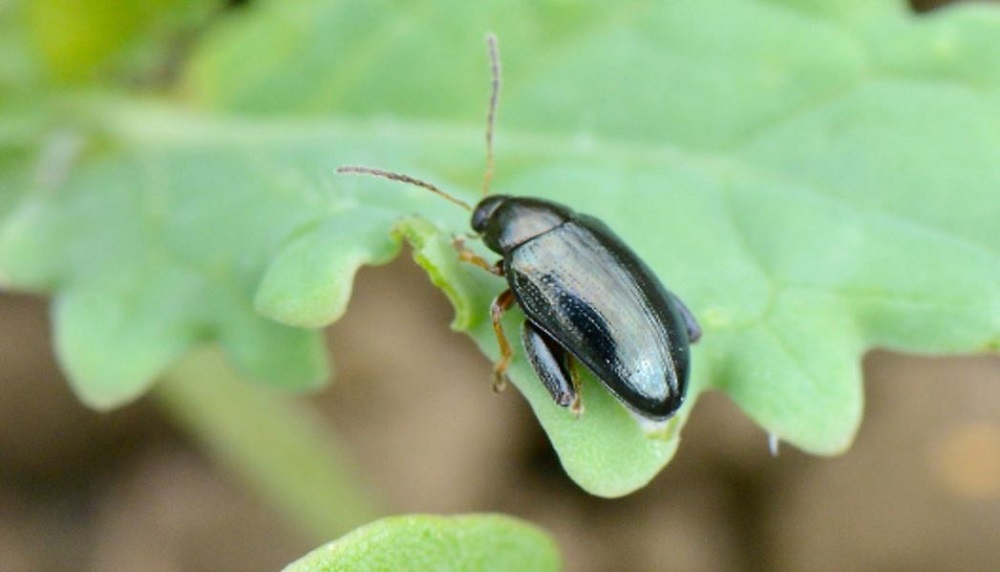OSR monitoring network strengthened to help predict CSFB migration
Tuesday, 13 August 2024
AHDB will monitor cabbage stem flea beetle (CSFB) at several winter oilseed rape (OSR) sites across England to track migration this autumn.
The activity is part of a long-term effort to determine the factors that affect adult CSFB migration, with the ultimate ambition being to provide a way to predict the start, duration and intensity of migration each year.
In addition to the manual monitoring of yellow water traps for adult beetles, the work will evaluate an automated monitoring technique.
The work will focus on sites in England, where the pest is most problematic.
CSFB IPM
Since neonicotinoid seed treatments were withdrawn in oilseed rape a decade ago, AHDB has invested in numerous projects on the potential of integrated pest management (IPM) approaches.
Earlier this year, Sacha White joined AHDB (as a Lead Crop Protection Scientist), having previously led several AHDB-funded CSFB research projects at ADAS.
Sacha said: “We now have a good handle on the components of a CSFB IPM strategy, including their strengths and weaknesses. Sowing dates are particularly influential, with a few weeks potentially making the difference between a good-yielding crop and a written-off crop.
“The most critical damage occurs when young crops encounter peak beetle migration, especially when soil moisture is low. Predicting migration windows would help farmers determine the lowest-risk point to sow OSR.”
Monitoring method
NIAB will lead the latest phase of the monitoring work, which includes assessments of CSFB at seven core monitoring sites. At these sites, yellow water traps will be inspected for adult beetles twice a week during the main migration risk period. Symptoms of crop invasion by larvae will also be noted.
Local variations in CSFB beetle pressure will also be assessed at strategic locations around one of the core sites (in Hertfordshire/Essex).
The monitoring data will strengthen a long-term data set that shows how CSFB migration varies annually and regionally (in response to local conditions). The information will be used to further develop and validate a decision support system that predicts local migration.
Earlier this year, Bayer launched an automated yellow water trap (MagicTrap) that catches insects and identifies and counts contents at regular intervals (using an integrated camera and artificial intelligence).
The MagicTraps, which have been used commercially in Germany for the past two seasons and supplied by Bayer at no cost to the project, will be co-located at the monitoring sites. This will allow comparisons between automated and manual monitoring techniques to be made.
Several farmers, mainly from AHDB’s Farm Excellence Network (which includes Monitor Farms and Strategic Cereal Farms), will also test MagicTraps this autumn.
To provide an indication of migration in 2024, updates on cumulative numbers of adult CSFB at monitoring sites will be published on the AHDB website (ahdb.org.uk/csfb).
Core monitoring sites
Yellow water traps and MagicTraps.
1 = Hertfordshire/Essex (six sites)
2 = Kent (east)
3 = Cambridgeshire (northwest)
4 = Dorset
5 = Yorkshire (north)
6 = Suffolk (north)
7 = Wiltshire (north)
Automated monitoring sites
MagicTraps only.
A = Strategic Cereal Farm East
B = Buckinghamshire & Bedfordshire Monitor Farm
C = Oxfordshire commercial farm
.JPG) AHDB
AHDB
Note: Map indicates approximate locations.
Notes to editors
Information on AHDB research on CSFB migration patterns is available in a recent blog post by Sacha White: ahdb.org.uk/news/pre-sowing-tips-to-tackle-cabbage-stem-flea-beetle-in-oilseed-rape
The AHDB Cereals & Oilseeds sector plan 2022–2027 includes a commitment to provide robust IPM information.
Levy payers continue to highlight CSFB as a major pest concern. Agronomists also continue to highlight the extreme crop losses associated with this pest and the importance of providing information on CSFB migration.
The cost of the current NIAB-led monitoring project is £24,280.80+VAT.
The project is one of the first to be recommended for funding by the new AHDB Cereals & Oilseeds R&KE committee. Further information on the R&KE committee is available at: ahdb.org.uk/research-ideas
IPM strategies are being investigated in a current AHDB (ADAS-led) project that ends this year. The project included CSFB monitoring for harvest 2021–23 crops: ahdb.org.uk/reducing-the-impact-of-cabbage-stem-flea-beetle-csfb-on-oilseed-rape-in-the-uk




